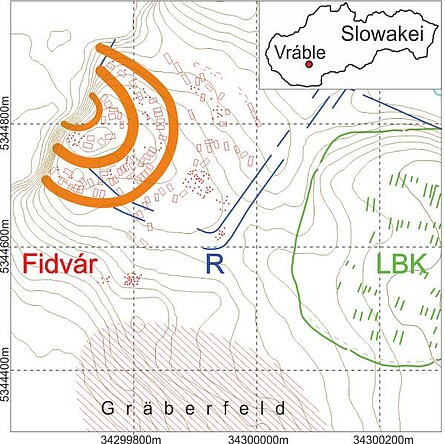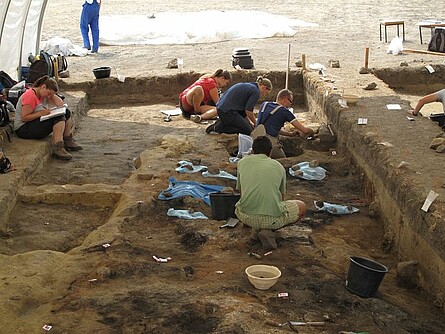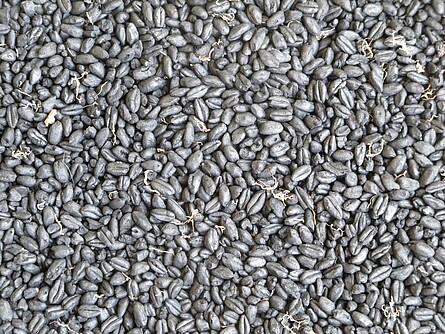Archaeobotanical and Palynological Analyses on Subsistence and Environmental Impact of the Bronze Age Settlement at Fidvár, Slovakia
The site of Fidvár near the town of Vráble is one of the most important settlements of the Early Bronze Age in Slovakia. Situated on the fertile Loess soils of the Danube Uplands and in the vicinity of the ore deposits of the close-by Carpathian Mountains, it was one of the largest settlements of its time. Evidence for Neolithic occupation and Roman-period ditch systems are testament of the settlement site’s appeal to humans.
The well-preserved, thick Early Bronze Age occupation layers as well as three consecutively used ditches are evidence of a varied occupation history of the Únetice-, Hatvan- und Mad’arovce cultures lasting several centuries. The numerous recorded house plots were located both inside and outside of the area fortified by ditches and ramparts. Pits were found alongside the houses as well as in separate areas beyond the actual settlement. An associated burial ground is adjoining on the south.
On occasion, the ditches, pits and houses have turned out to be very productive archaeological archives. It was, for instance, possible to recover several kilograms of burnt cereal grain from within the house plots. Changes in the economies of the Early Bronze Age cultures as well as differences between individual settlement areas are intended to be studied through analysing changes in the cereal spectra. Apart from archaeobotanical assessments, the reconstruction of prehistoric living conditions will also include palynological investigations as well as analyses of the recovered charcoal and mollusc assemblages. Isotope analyses are promising additional information on arable practices.
The archaeobotanical analyses will be carried out at the NIhK by Dr. Frank Schlütz. The project is part of the research network “Fidvár near Vráble – a settlement at the junction of the ancient European metallurgical provinces. Intercultural dynamics and environmental changes in a key region for landscape ecology in eastern Central Europe”, carried out in cooperation between the Roman-Germanic Commission, Frankfurt, the Geographic Institute of Heidelberg University, the German Mining Museum Bochum and the Archaeological Institute of the Slovak Academy of Sciences. The project is funded by the German Research Foundation (DFG).
Bibliography
Bátora, J., Behrens, A., Gresky, J., Ivanova, M., Rassmann, K., Tóth, P., Winkelmann, K. (2012): The Rise and Decline of the Early Bronze Age Settlement Fidvár near Vráble, Nitra. In: Kneisel, J., Kirleis, W., DalCorso, M., Taylor, N., Tiedtke, V. (Eds.): Collapse or Continuity? Environment and Development of Bronze Age Human Landscapes. Bonn: 111-129.
Ivanova, M., Schlütz, F., Benecke, N. (in review): Subterranean silos at Vráble, southwestern Slovakia: a case study of geochemistry and distribution of finds in fill deposits.
Nowaczinski, E. (2014): Multi-scale geomorphological and geoarchaeological investigations of a key site - The Early Bronze Age settlement of Fidár (Slovakia). Heidelberg. katalog.ub.uni-heidelberg.de/cgi-bin/titel.cgi
Schlütz, F., Bittmann, F. (2015): Archäobotanische und pollenanalytische Untersuchungen zu Subsistenz und Umwelteinfluss der bronzezeitlichen Siedlung Fidvár bei Vráble (Slowakei). Siedlungs- und Küstenforschung im südlichen Nordseegebiet, 38: 271-285.
Schlütz, F., Bittmann, F. (2016): Dating Archaeological Cultures by Their Moats? A Case Study from the Early Bronze Age Settlement Fidvár near Vráble, SW Slovakia. In: Radiocarbon 58 (2), S. 331–343. DOI: 10.1017/RDC.2015.17.



